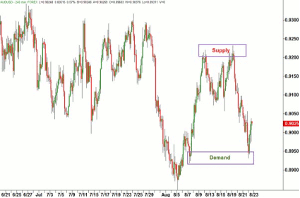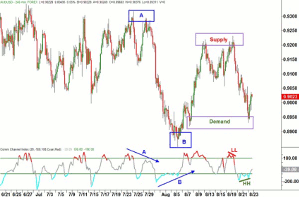Sam Evans of Online Trading Academy demonstrates how the use of a simple technical indicator can help you analyze a set-up objectively and give you a secondary reason to take the trade.
As many of my readers will know from my previous pieces, I like to focus the majority of my trading analysis on nothing more than price itself. To me and my fellow instructors at Online Trading Academy, all indicators are nothing more than a result of price movement. To solely rely on a technical indicator to give you a reason to enter a trade, either long or short, would be unwise because a trader needs to understand how price moves in the first place before relying on anything else to make a decision to enter or exit the market. This is why we teach our rule-based core strategy of recognizing institutional supply and demand on any market and on any given time frame. By recognizing the behavior of institutions, our students have an edge in the marketplace which allows them to buy low and sell high with a very low risk and incredible potential reward. If you know what a picture of supply and demand looks like on a price chart, everything else becomes secondary.
As you have seen in my previous articles, I have explained the how we look at supply and demand on a price chart in detail. We identify what a buy zone looks like and what a sell zone looks like and place our trades accordingly. By marking off our areas of entry in advance, we have the added advantage of knowing exactly how much we risk on the trade should it not work in our favor and also knowing how much we are shooting for as a profit target. By eliminating the emotions and the guesswork, we allow ourselves to follow a rule-based plan and control our risk management at all times with discipline. However, it should be recognized that part of trading is also finding your own character around your plan and not every single trader is going to trade in exactly the same way.
Typically, when I show a new student our strategy that we use at the market, they think that we have something against technical indicators because our strategy relies on price and nothing more. Let me state this though: we really don’t have anything against indicators! Rather we like to encourage the student to first understand the simplicity of trading and how buying low and selling high requires nothing more than recognizing and understanding what you’re looking for on a price chart. For some, the information on the price chart is more than enough. For others, they look to increase their edge a little bit further and that’s where technical indicators can become a very useful tool if used in the correct manner and with a solid set of rules in place. For today, I would like to talk about the Commodity Channel Index also known as the CCI.
The CCI is an oscillator and a versatile one at that. It was originally introduced to traders by Donald Lambert in an article published in 1980. Since its introduction, it has found favor with traders of multiple asset classes not solely commodities in which it was originally used. Its basic principles lie in a simple calculation, which is the difference between the typical price of the security and its simple moving average, divided by the mean absolute deviation of the typical price. Effectively it measures conditions of both overbought and oversold and also measures the strength and weakness of the current market trends.
NEXT PAGE: Details of the Strategy
|pagebreak|Amongst the majority of market speculators, measuring overbought and oversold is the most common use of the CCI, however I think a very simple trick is to use it as a means of looking at price divergences. Used in conjunction with a good solid understanding of supply and demand zones, CCI divergences can be a neat little tool to getting a heads up of when prices are likely to carry on or reverse. Let’s look at an example:
In the below example, I have taken a four-hour chart of the Australian dollar versus the US dollar and highlighted an area of supply and an area of demand, which match our odds enhancers scores. For the majority of our students, recognizing the turning points in advance and scoring the levels accordingly, is more than enough analysis required to place a trade, stop loss and target with confidence.
However, with a little objective analysis, applying the CCI indicator can also give some subtle clues as to when a level is likely to hold or not. Our strategy does not work every single time. No strategy in trading works every single time but this does not mean that you can’t create an extra edge when picking out a reason to enter the marketplace. Let’s apply the CCI indicator to the same price chart and take a look at what extra information it gives us:
In this example, I have marked off some specific areas to address. Firstly, notice where prices fell from point A on the chart. Directly underneath this point where the CCI is applied, you can see a downward slope at the adjacent point A. The indicator itself is making lower lows and lower highs. Imagine the CCI is like a gauge of momentum. On the second test of the pivot high at point A, we can see that the CCI put in a lower low at this point with a lower force, thus suggesting an end of the upward trend and a new downward trend potential. Likewise at the pivot low of point B, we can see that the CCI was beginning to slope upwards making higher highs and higher lows, suggesting a weakening downward pressure and strengthening upward pressure. I tend to visualize the action of the indicator like a throttle with more pressure being applied in a strong trend and less pressure being applied as the trend is weakening. Think of it like more gas equals more momentum.
We can also see a use of the CCI when we already have a supply or demand zone marked off in advance. The same two levels, which I showed you in the first example now have the indicator attached to them. We already knew what we wanted to do at the levels for example, selling at supply and buying at demand, however the CCI offers us an extra level of certainty in the trade. Notice how when price is at supply on the second retest of the zone, the CCI forms lower lows and on the second retest of the lower demand zone the indicator produces higher highs? This is what we call diversions between indicator and price, which always suggests a potential reversal in trend and the slowdown of momentum.
Of course, we would never use divergences solely as a reason to buy or sell in the market and would always back up our trading decisions with a solid reason to enter in the first place, for example core strategy. The CCI oscillator is there as an extra tool which offers us confluence in a simple manner, so as to help us analyze objectively and give us a secondary reason to take the trade. Please remember that whenever you’re going to use a technical indicator of any kind, you always need to focus on price first and foremost. Sticking to this rule is always going to help you have a healthy and more successful trading strategy.
Sam Evans, Trading Instructor, Online Trading Academy























